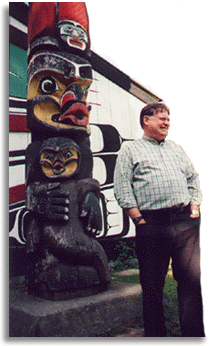Curator's Statement
 My interest in Emily Carr's interpretations of Northwest Coast villages and totem poles dates back to December 1965. During my first week as assistant anthropologist at the (now) Royal British Columbia Museum in Victoria, colleagues introduced me to a huge collection of historic photographs of First Nations subjects.
My interest in Emily Carr's interpretations of Northwest Coast villages and totem poles dates back to December 1965. During my first week as assistant anthropologist at the (now) Royal British Columbia Museum in Victoria, colleagues introduced me to a huge collection of historic photographs of First Nations subjects.
Among the photographs was a print of Blunden Harbour, a remote Kwakwaka'wakw village on the central British Columbia coast. At that time the village was known to me only through Emily Carr's painting of the same title. Inscribed on the back was a notation by Willie Newcombe, confidante and handyman to Carr during her years as a landlady, indicating that his father, Dr. Charles F. Newcombe, had photographed the village in 1901. He goes on to record that he loaned the print to Carr about 1930 and that she "painted Blunden Harbour from it . . . never having had an opportunity of visiting this village personally."
As I worked through the collection, I discovered Carr had used photographer Richard Maynard's 1884 view of Captain Gold's house as the basis for her painting House Front, Gold Harbour. Several other photographs, taken on Haida Gwaii, proved to be sources for Carr works depicting poles at Haina, Skidegate, Masset and Hiellen.
Hanging in my office at the time were two paintings of Alert Bay by F.M. Bell-Smith. One day, Kwagul chief Tommy Hunt commented on them. He recognized the locale but was puzzled by the rendering of a large canoe, which he identified as a hybrid so high and narrow it could never put safely to sea. I realized he had been reading the painting as if it were a photograph and was perplexed by its lack of veracity.
Over the ensuing three or four years, these experiences led to in-depth examinations with First Nations people of both photographs and paintings.
The exercise was rewarding and revealing. Chief Bill Scow commented on his father's house and the carving of Dzunuk'wa at Gwa'yasdams village, both subjects of Carr paintings. Chief Peter Smith examined Walter J. Phillips's Raising a Zunuk and explained why, when he repositioned the houseposts, he placed oak barrels where the beams used to rest. Agnes Cranmer corrected Phillips and Carr's misidentification of the Thunderbird figure in the Alert Bay cemetery. Chief J.J. Wallas insisted that Carr's Zunoqua of the Cat Village was actually a male ancestor. Chief Tommy Hunt described chiefs being ejected from Wakas's house at Alert Bay via the Raven's projecting lower beak. Gloria Cranmer Webster provided an accurate description for Carr's Pow Wow Platform, Alert Bay. Chief Jack Peters, inspired by his viewing of Carr's painting on a television program, told stories about life in his father's gukwdzi (Big House) at T'sadzis'nukwaame'. Chief Arthur Dick identified the owner of both house and pole at 'Mi'mkwamlis featured in works by Carr and Phillips.
In 1966 Henry and Tony Hunt, carvers at the Royal British Columbia Museum, completed a replica of a Haida house frontal pole, popularly called "Weeping Woman of Tanoo," and painted in both watercolour and oil by Carr. Charged with writing a descriptive museum label for the pole, I discovered, in pioneering ethnologist and professional artifact collector C.F. Newcombe's fieldnotes, that the image is neither weeping nor a woman. It is a mythic sea chief whose eyes fall out of their sockets each night and have to be reinserted by friends the next day.
I was never able to do anything with my growing file of notes other than to direct a generation of students and scholars to Carr's use of photographs for some of her Haida paintings. When I was asked to curate an exhibition of Carr's work depicting First Nations subjects for the Art Gallery of Greater Victoria, I jumped at the chance. But I felt that both Carr and scholarship would be better served if the viewer was given an opportunity to compare Carr's work to that of several contemporaries who also painted the totem pole villages. As well, the voice of First Nations people had to be introduced through first-person testimony and anthropological records in order to contextualize the paintings and correct misinterpretations which were unwittingly introduced by the artists. Including contemporaneous photographs provides a vehicle for this voice and also presents a context for the art works beyond the confines of their frames, offering the viewer new insights into the depiction of Northwest Coast monumental sculpture by artists during the first three decades of the twentieth century.
Peter Macnair, Curator
Peter Macnair's Curricula vitalae
On to Introduction to Exhibit
|

